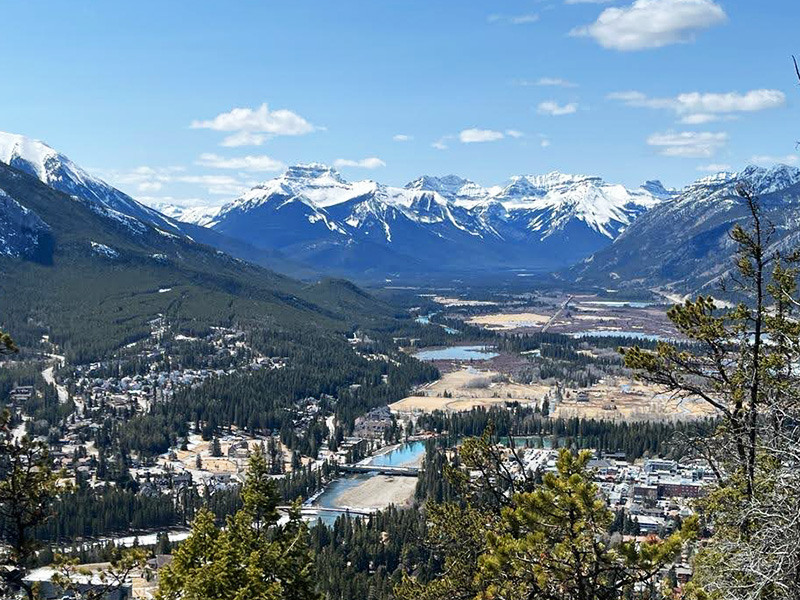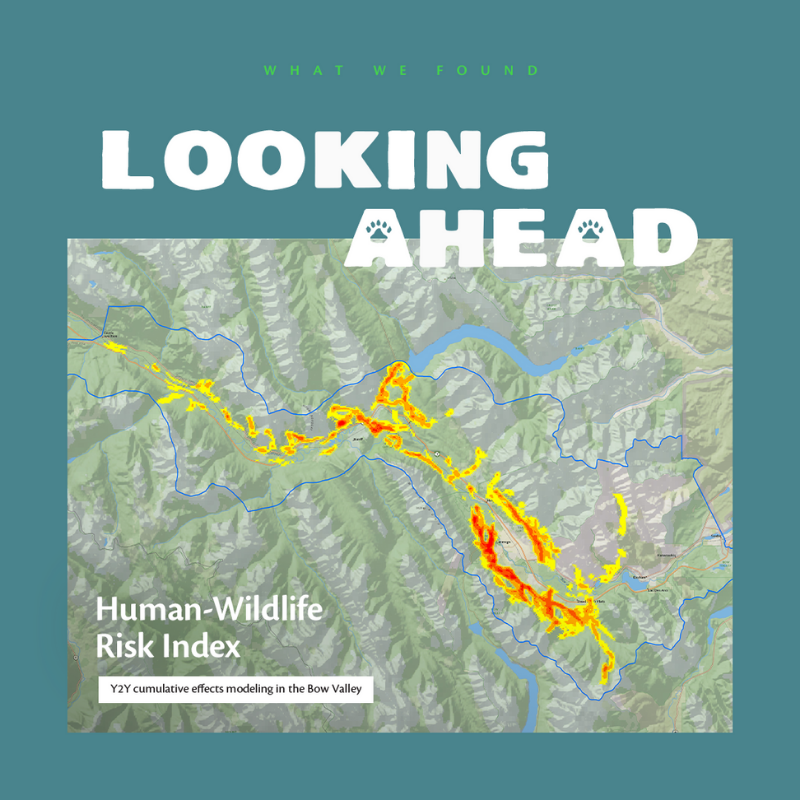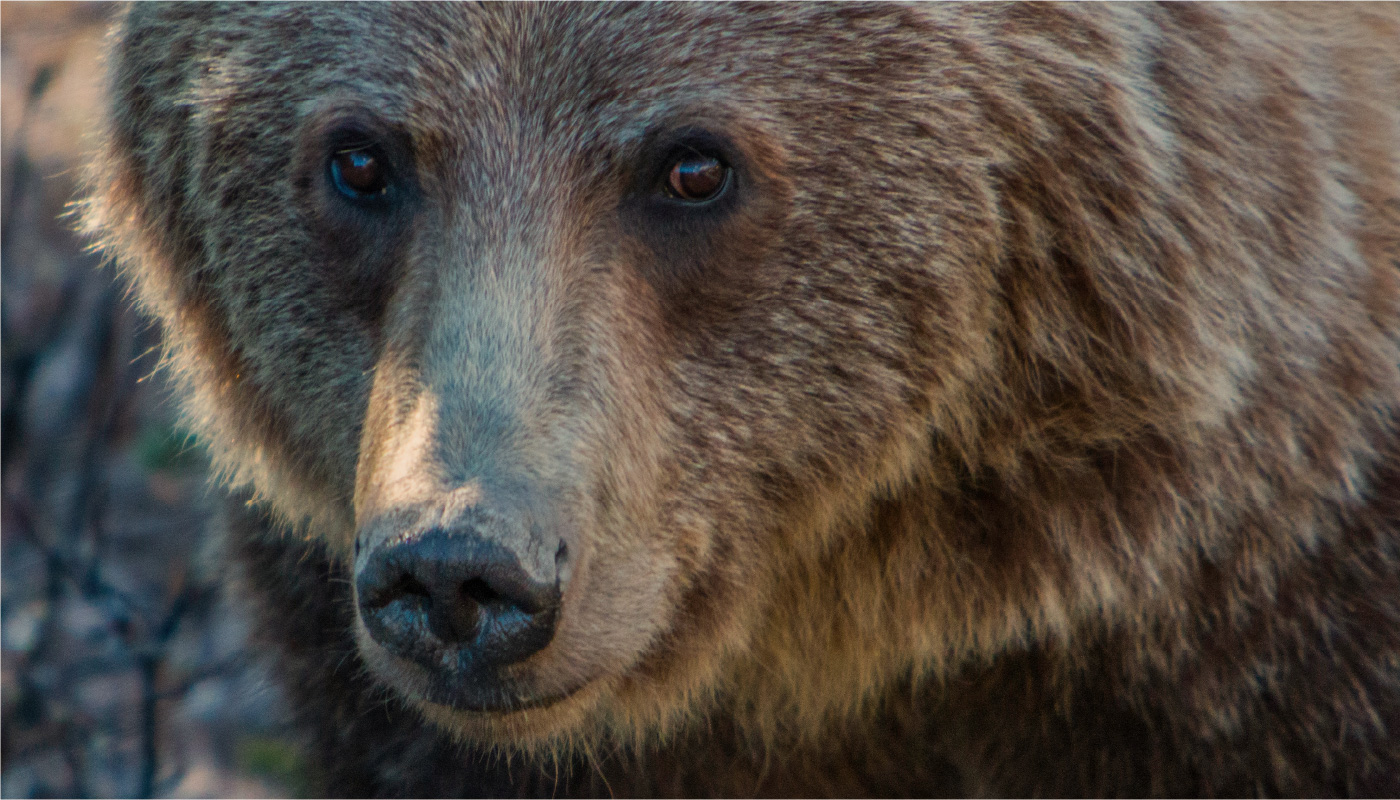The Yellowstone to Yukon Conservation Initiative (Y2Y) and ALCES Landscape and Land-Use, with input from the Town of Canmore, Town of Banff, and Alberta Parks, modeled past, present and future scenarios for grizzly bear movement in Alberta’s Bow Valley in 2021.
Grizzly bear movement and conflict risk in the Bow Valley
This cumulative effects modeling is meant to help understand how decisions regarding development, people and recreation impact grizzly bears in this busy landscape.
The modeling shows that grizzly bear movement paths have already been dramatically altered, and proposed development would move those routes even further upslope.
Expected growth in development and recreation in the Bow Valley would considerably increase the risk of conflict between people and grizzly bears in the future; but, carefully planned development and well managed recreation could significantly reduce how much that risk increases.
Human-bear conflict for the Canmore area in particular is at risk of rising in the future, but also shows the greatest potential for reduction through proactive measures.
Completed in early 2022, the modeling report is now available. In September 2022, the findings were also published as a peer-reviewed paper in Environmental Management: Supplementing environmental assessments with cumulative effects scenario modeling for grizzly bear connectivity in the Bow Valley, Alberta, Canada.

Understanding wildlife movement in a busy landscape
The Bow Valley is one of the four most important east-west connectors in the entire 3,400-kilometer-long (2,100 mile) length of the Yellowstone to Yukon region, and one of two such valleys in Alberta.
Wildlife such as deer, elk, wolves, cougars and grizzly bears are known to use these valleys for food, habitat and as important migration corridors. The focus of this work is on grizzly bears, both for their own sake and because, as an umbrella species, meeting the needs of grizzly bears means meeting the needs of many other species as well.
With many pressures on the Bow Valley, every planning decision must be made with an understanding of overall cumulative effects. Otherwise, we risk losing a significant part of what makes this area so special in the first place: the wild animals that have always been here.
Through this work, Y2Y aims to provide planners and decision-makers with strong science-based information about wildlife movement in the Bow Valley and a clearer view of how to achieve their goals and priorities for coexistence. It also considers some trade-offs that might need to be made to get there.
The area of focus for this model runs along the Bow Valley from Castle Junction to the Kananaskis River, in keeping with the Bow Valley Human-Wildlife Coexistence Roundtable.
What is the cumulative effects approach?
Cumulative effects are the impact diverse activities have on a specific area over time. These activities range from recreation, to residential and industrial development, and the building or increasing use of roads or railways.
Rather than attempting to look at the impact of a single decision on a very localized area, a cumulative effects approach attempts to understand the ways that many different decisions together impact the broader landscape and how it functions.
Since the 1970s, the Town of Canmore’s human footprint has grown more than five times. Yet, the busy, developed landscape of the Bow Valley is one of the few in the world that people and grizzly bears still share.
With many pressures on this rather narrow valley, every planning decision must be made with an understanding of overall cumulative effects. Otherwise, we risk losing a significant part of what makes this area so special in the first place: the wild animals that have always been here.
What impact do today’s decisions have on people and wildlife in the future?
The ALCES Online model was used to simulate the cumulative effects of land use on grizzly bears’ preferred movement paths. This type of modeling is a knowledge-building exercise, producing data to inform planning processes and enhance decision-makers’ ability to achieve their long-term goals.
It’s about understanding, as best we can, the impacts our decisions today could have on people and wildlife in the future.
The analysis explores changes in land use footprints (such as roads, trails and buildings) and human activity since European colonization but especially since 1970. It also explores present-day and potential future land use scenarios associated with expected growth in human population and visitation.
A look at the results
Results of our cumulative effects modeling show that human activity has impacted grizzly bear movement, but also show that the right decisions can make a positive impact:
- Development and recreation have already significantly changed likely grizzly bear movement paths in the Bow Valley, forcing the bears onto steeper, less desirable terrain.
- Projected growth in population and visitation in the Bow Valley would considerably increase the risk of dangerous encounters between people and grizzly bears.
- Management strategies have the potential to considerably reduce the growing risk of encounters between people and grizzly bears in the Bow Valley, matters of particular concern around Canmore.
A decline in conflict with people means better opportunities for grizzly bears to move as they need in order to sustain healthy bear populations in the long term, as well as a safer experience for those recreating in these shared landscapes.

How you can help
Write your elected official to ask for dedicated funds for improved management of trail systems in the Bow Valley, including trail planning and reclamation, signage, education, and enforcement. Use this tool to search for your MLA.
Who are we working with?
- ALCES Group
- Bow Valley Cumulative Effects Advisory Group with representatives from Town of Canmore, Town of Banff, and Alberta Parks
This initiative was made possible in part through grants from the Alpine Club of Canada’s Environment Fund, Banff Canmore Community Foundation, and Alberta Ecotrust.


